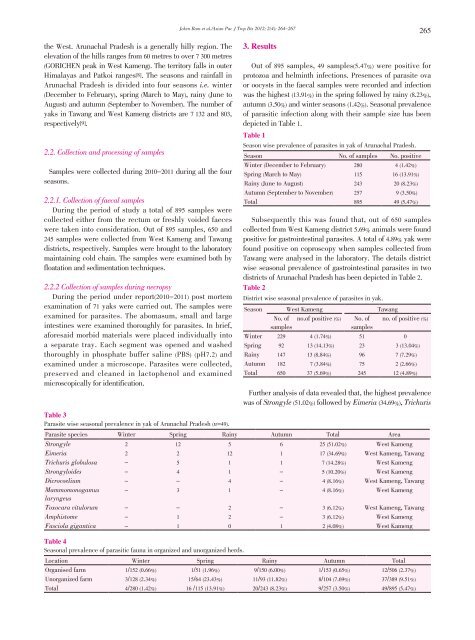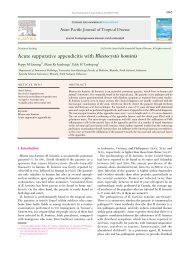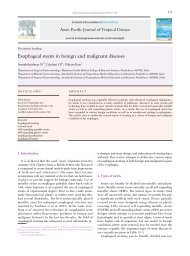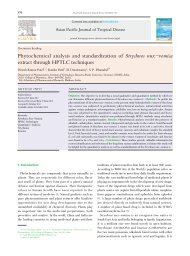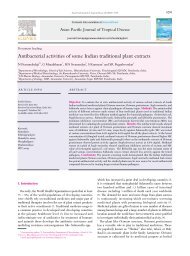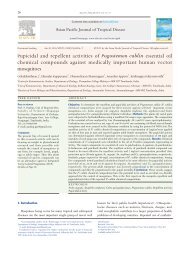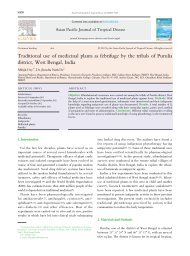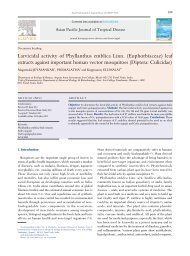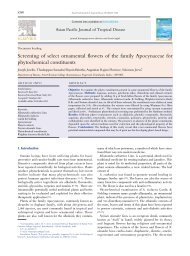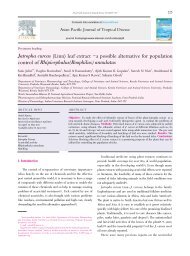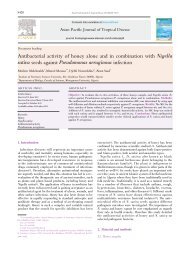Seasonal prevalence of parasitic infection of yaks in Arunachal ...
Seasonal prevalence of parasitic infection of yaks in Arunachal ...
Seasonal prevalence of parasitic infection of yaks in Arunachal ...
Create successful ePaper yourself
Turn your PDF publications into a flip-book with our unique Google optimized e-Paper software.
the West. <strong>Arunachal</strong> Pradesh is a generally hilly region. The<br />
elevation <strong>of</strong> the hills ranges from 60 metres to over 7 300 metres<br />
(GORICHEN peak <strong>in</strong> West Kameng). The territory falls <strong>in</strong> outer<br />
Himalayas and Patkoi ranges[8]. The seasons and ra<strong>in</strong>fall <strong>in</strong><br />
<strong>Arunachal</strong> Pradesh is divided <strong>in</strong>to four seasons i.e. w<strong>in</strong>ter<br />
(December to February), spr<strong>in</strong>g (March to May), ra<strong>in</strong>y (June to<br />
August) and autumn (September to November). The number <strong>of</strong><br />
<strong>yaks</strong> <strong>in</strong> Tawang and West Kameng districts are 7 132 and 803,<br />
respectively[9].<br />
2.2. Collection and process<strong>in</strong>g <strong>of</strong> samples<br />
Samples were collected dur<strong>in</strong>g 2010-2011 dur<strong>in</strong>g all the four<br />
seasons.<br />
2.2.1. Collection <strong>of</strong> faecal samples<br />
Dur<strong>in</strong>g the period <strong>of</strong> study a total <strong>of</strong> 895 samples were<br />
collected either from the rectum or freshly voided faeces<br />
were taken <strong>in</strong>to consideration. Out <strong>of</strong> 895 samples, 650 and<br />
245 samples were collected from West Kameng and Tawang<br />
districts, respectively. Samples were brought to the laboratory<br />
ma<strong>in</strong>ta<strong>in</strong><strong>in</strong>g cold cha<strong>in</strong>. The samples were exam<strong>in</strong>ed both by<br />
floatation and sedimentation techniques.<br />
2.2.2 Collection <strong>of</strong> samples dur<strong>in</strong>g necropsy<br />
Dur<strong>in</strong>g the period under report(2010-2011) post mortem<br />
exam<strong>in</strong>ation <strong>of</strong> 71 <strong>yaks</strong> were carried out. The samples were<br />
exam<strong>in</strong>ed for parasites. The abomasum, small and large<br />
<strong>in</strong>test<strong>in</strong>es were exam<strong>in</strong>ed thoroughly for parasites. In brief,<br />
aforesaid morbid materials were placed <strong>in</strong>dividually <strong>in</strong>to<br />
a separate tray. Each segment was opened and washed<br />
thoroughly <strong>in</strong> phosphate buffer sal<strong>in</strong>e (PBS) (pH7.2) and<br />
exam<strong>in</strong>ed under a microscope. Parasites were collected,<br />
preserved and cleaned <strong>in</strong> lactophenol and exam<strong>in</strong>ed<br />
microscopically for identification.<br />
Table 3<br />
Parasite wise seasonal <strong>prevalence</strong> <strong>in</strong> yak <strong>of</strong> <strong>Arunachal</strong> Pradesh (n=49).<br />
Joken Bam et al./Asian Pac J Trop Dis 2012; 2(4): 264-267 265<br />
3. Results<br />
Out <strong>of</strong> 895 samples, 49 samples(5.47%) were positive for<br />
protozoa and helm<strong>in</strong>th <strong><strong>in</strong>fection</strong>s. Presences <strong>of</strong> parasite ova<br />
or oocysts <strong>in</strong> the faecal samples were recorded and <strong><strong>in</strong>fection</strong><br />
was the highest (13.91%) <strong>in</strong> the spr<strong>in</strong>g followed by ra<strong>in</strong>y (8.23%),<br />
autumn (3.50%) and w<strong>in</strong>ter seasons (1.42%). <strong>Seasonal</strong> <strong>prevalence</strong><br />
<strong>of</strong> <strong>parasitic</strong> <strong><strong>in</strong>fection</strong> along with their sample size has been<br />
depicted <strong>in</strong> Table 1.<br />
Table 1<br />
Season wise <strong>prevalence</strong> <strong>of</strong> parasites <strong>in</strong> yak <strong>of</strong> <strong>Arunachal</strong> Pradesh.<br />
Season No. <strong>of</strong> samples No. positive<br />
W<strong>in</strong>ter (December to February) 280 4 (1.42%)<br />
Spr<strong>in</strong>g (March to May) 115 16 (13.91%)<br />
Ra<strong>in</strong>y (June to August) 243 20 (8.23%)<br />
Autumn (September to November) 257 9 (3.50%)<br />
Total 895 49 (5.47%)<br />
Subsequently this was found that, out <strong>of</strong> 650 samples<br />
collected from West Kameng district 5.69% animals were found<br />
positive for gastro<strong>in</strong>test<strong>in</strong>al parasites. A total <strong>of</strong> 4.89% yak were<br />
found positive on coproscopy when samples collected from<br />
Tawang were analysed <strong>in</strong> the laboratory. The details district<br />
wise seasonal <strong>prevalence</strong> <strong>of</strong> gastro<strong>in</strong>test<strong>in</strong>al parasites <strong>in</strong> two<br />
districts <strong>of</strong> <strong>Arunachal</strong> Pradesh has been depicted <strong>in</strong> Table 2.<br />
Table 2<br />
District wise seasonal <strong>prevalence</strong> <strong>of</strong> parasites <strong>in</strong> yak.<br />
Season West Kameng Tawang<br />
No. <strong>of</strong> no.<strong>of</strong> positive (%) No. <strong>of</strong> no. <strong>of</strong> positive (%)<br />
samples<br />
samples<br />
W<strong>in</strong>ter 229 4 (1.74%) 51 0<br />
Spr<strong>in</strong>g 92 13 (14.13%) 23 3 (13.04%)<br />
Ra<strong>in</strong>y 147 13 (8.84%) 96 7 (7.29%)<br />
Autumn 182 7 (3.84%) 75 2 (2.66%)<br />
Total 650 37 (5.69%) 245 12 (4.89%)<br />
Further analysis <strong>of</strong> data revealed that, the highest <strong>prevalence</strong><br />
was <strong>of</strong> Strongyle (51.02%) followed by Eimeria (34.69%), Trichuris<br />
Parasite species W<strong>in</strong>ter Spr<strong>in</strong>g Ra<strong>in</strong>y Autumn Total Area<br />
Strongyle 2 12 5 6 25 (51.02%) West Kameng<br />
Eimeria 2 2 12 1 17 (34.69%) West Kameng, Tawang<br />
Trichuris globulosa - 5 1 1 7 (14.28%) West Kameng<br />
Strongyloides - 4 1 - 5 (10.20%) West Kameng<br />
Dicrocoelium - - 4 - 4 (8.16%) West Kameng, Tawang<br />
Mammomonogamus<br />
laryngeus<br />
- 3 1 - 4 (8.16%) West Kameng<br />
Toxocara vitulorum - - 2 - 3 (6.12%) West Kameng, Tawang<br />
Amphistome - 1 2 - 3 (6.12%) West Kameng<br />
Fasciola gigantica - 1 0 1 2 (4.08%) West Kameng<br />
Table 4<br />
<strong>Seasonal</strong> <strong>prevalence</strong> <strong>of</strong> <strong>parasitic</strong> fauna <strong>in</strong> organized and unorganized herds.<br />
Location W<strong>in</strong>ter Spr<strong>in</strong>g Ra<strong>in</strong>y Autumn Total<br />
Organised farm 1/152 (0.66%) 1/51 (1.96%) 9/150 (6.00%) 1/153 (0.65%) 12/506 (2.37%)<br />
Unorganized farm 3/128 (2.34%) 15/64 (23.43%) 11/93 (11.82%) 8/104 (7.69%) 37/389 (9.51%)<br />
Total 4/280 (1.42%) 16 /115 (13.91%) 20/243 (8.23%) 9/257 (3.50%) 49/895 (5.47%)


